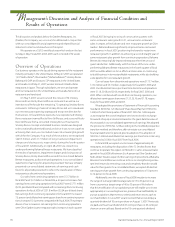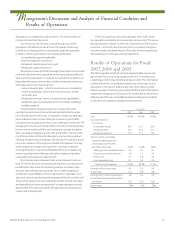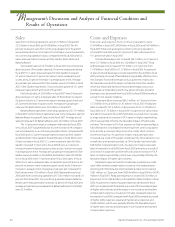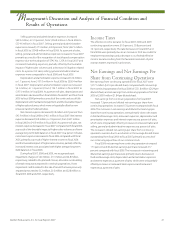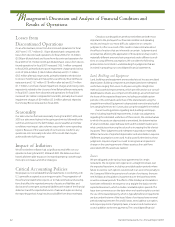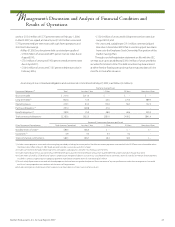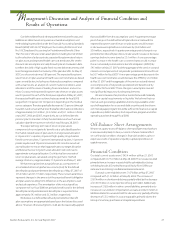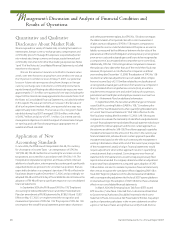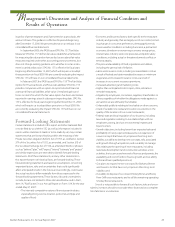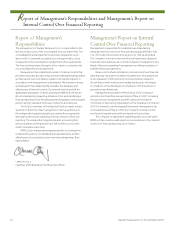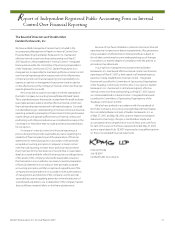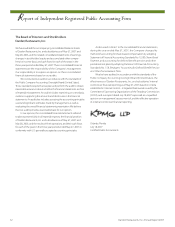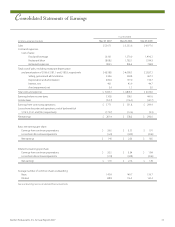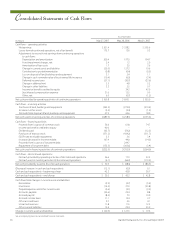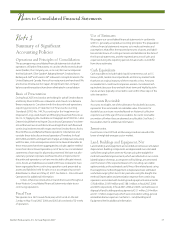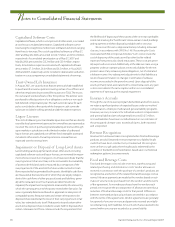Red Lobster 2007 Annual Report Download - page 30
Download and view the complete annual report
Please find page 30 of the 2007 Red Lobster annual report below. You can navigate through the pages in the report by either clicking on the pages listed below, or by using the keyword search tool below to find specific information within the annual report.
28 Darden Restaurants, Inc. Annual Report 2007
Management’s Discussion and Analysis of Financial Condition and
Results of Operations
M
Quantitative and Qualitative
Disclosures About Market Risk
We are exposed to a variety of market risks, including fluctuations in
interest rates, foreign currency exchange rates, compensation and
commodity prices. To manage this exposure, we periodically enter
into interest rate, foreign currency exchange, equity forwards and
commodity instruments for other than trading purposes (see Notes
1 and 10 of the Notes to Consolidated Financial Statements, included
elsewhere in this report).
We use the variance/covariance method to measure value
at risk, over time horizons ranging from one week to one year, at
the 95 percent confidence level. At May 27, 2007, our potential
losses in future net earnings resulting from changes in foreign
currency exchange rate instruments, commodity instruments,
equity forwards and floating rate debt interest rate exposures were
approximately $11.6 million over a period of one year (including the
impact of the interest rate swap agreements discussed in Note 10 of
the Notes to Consolidated Financial Statements, included elsewhere
in this report). The value at risk from an increase in the fair value of
all of our long-term fixed rate debt, over a period of one year, was
approximately $44.4 million. The fair value of our long-term fixed
rate debt during fiscal 2007 averaged $599.2 million, with a high
of $642.7 million and a low of $477.1 million. Our interest rate risk
management objective is to limit the impact of interest rate changes
on earnings and cash flows by targeting an appropriate mix of
variable and fixed rate debt.
Application of New
Accounting Standards
In June 2006, the FASB issued Interpretation No. 48, “Accounting
for Uncertainty in Income Taxes – an interpretation of SFAS No.
109” (FIN 48). FIN 48 clarifies the accounting for uncertain income
tax positions accounted for in accordance with SFAS No. 109. The
Interpretation stipulates recognition and measurement criteria in
addition to classification, interim period accounting and significantly
expanded disclosure provisions for uncertain tax positions that are
expected to be taken in a company’s tax return. FIN 48 is effective for
fiscal years beginning after December 15, 2006, and accordingly, we
adopted FIN 48 as of the first day of fiscal 2008. We do not believe the
adoption of FIN 48 will have a significant impact on our consolidated
financial statements.
In September 2006, the FASB issued SFAS No. 158, “Employers’
Accounting for Defined Benefit Pension and Other Postretirement
Plans (an amendment of FASB Statements No. 87, 88, 106 and 132R).”
Effective May 27, 2007, we implemented the recognition and
measurement provision of SFAS No. 158. The purpose of SFAS No. 158
is to improve the overall financial statement presentation of pension
and other postretirement plans, but SFAS No. 158 does not impact
the determination of net periodic benefit cost or measurement
of plan assets or obligations. SFAS No. 158 requires companies to
recognize the over or under funded status of the plan as an asset or
liability as measured by the difference between the fair value of the
plan assets and the benefit obligation and requires any unrecognized
prior service costs and actuarial gains and losses to be recognized as
a component of accumulated other comprehensive income (loss).
Additionally, SFAS No. 158 no longer allows companies to measure
their plans as of any date other than as of the end of their fiscal year.
However, this provision is not effective for companies until fiscal
years ending after December 15, 2008. The adoption of SFAS No. 158
resulted in an after-tax adjustment to accumulated other compre-
hensive income (loss) of $31.8 million related to a reclassification of
unrecognized actuarial gains and losses from assets to a component
of accumulated other comprehensive income (loss), as well as a
requirement to recognize over and under funding of our pension,
post-retirement health plan and employee severance accrual. See
Note 16 – Retirement Plans for additional information.
In September 2006, the Securities and Exchange Commission
issued Staff Accounting Bulletin (SAB) No. 108, “Considering the
Effects of Prior Year Misstatements when quantifying Misstatements
in Current Year Financial Statements.” SAB 108 is effective for the
first fiscal year ending after November 15, 2006. SAB 108 requires
companies to evaluate the materiality of identified unadjusted errors
on each financial statement and related financial statement disclosure
using both the rollover approach and the iron curtain approach, as
those terms are defined in SAB 108. The rollover approach quantifies
misstatements based on the amount of the error in the current year
financial statements, whereas the iron curtain approach quantifies
misstatements based on the effects of correcting the misstatement
existing in the balance sheet at the end of the current year, irrespective
of the misstatement’s year(s) of origin. Financial statements would
require adjustment when either approach results in quantifying
a misstatement that is material. Correcting prior year financial
statements for immaterial errors would not require previously filed
reports to be amended. If a company determines that an adjustment
to prior year financial statements is required upon adoption of SAB
108 and does not elect to restate its previous financial statements,
then it must recognize the cumulative effect of applying SAB 108 in
fiscal 2007 beginning balances of the affected assets and liabilities
with a corresponding adjustment to the fiscal 2007 opening balance
in retained earnings. The adoption of SAB 108 did not have a material
effect on our consolidated financial statements.
In March 2006, the Emerging Issues Task Force (EITF) issued
EITF Issue 06-3, “How Taxes Collected from Customers and Remitted
to Governmental Authorities Should Be Presented in the Income
Statement (That is, Gross versus Net Presentation).” Entities may adopt
a policy of presenting sales taxes in the income statement on either
a gross or net basis. If taxes are significant, an entity should disclose


